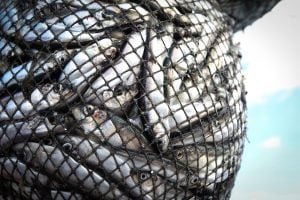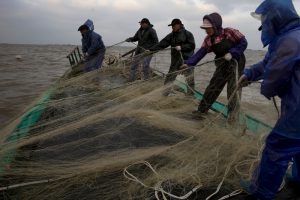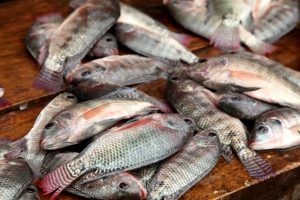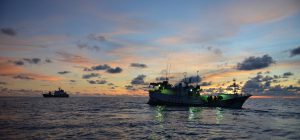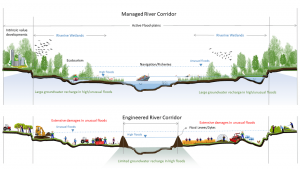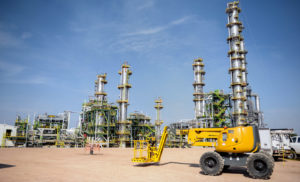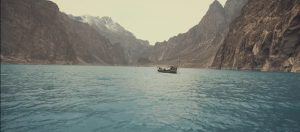Marcy Trent Long: Hi! My name is Marcy Trent Long. Welcome to Sustainable Asia. 1986 is made in collaboration with chinadialogue. It’s a four-part podcast series about China, oceans and fish.
This is episode three of 1986 – a story of how China is breaking the cycle of overfishing that was unleashed with the passage of the 1986 Fisheries Law during their reform and opening period.
Previously on episode two…
Cao Ling: Starting from 2020, fishing will be completely banned in the Yangtze river for 10 years.
John Mimikakis: They’re also pushing to reduce the total number of fishing boats on the water. China has about a million fishing boats on the water. The whole world has around four. So about a quarter of all the fishing boats in the world are Chinese vessels, and they’re fishing mostly in China’s domestic waters.
Marcy: In 1986, China passed a fisheries law that privatised fishing vessels and moved China from a country of wooden-boat fishing communes into the modern world of mechanised, commercial fishing trawlers. Now China is by far the biggest producer and consumer of fish products globally. And since 2002, China has been the world’s leading exporter of fish products. China’s fishing industry, however, is increasingly the victim of its own success. In this episode three, we look at domestic aquaculture – how it’s struggled with the pressures of China’s economic growth, and why it’s making China’s coastal overfishing problem even worse.
Wang Songlin: I think the history of China’s aquaculture pretty much dates back to 3,000 years ago, starting with the freshwater pond culture that you can find in the historical records.
Marcy: That was Songlin Wang, chairman of Qingdao Marine Conservation Society and China programme director for Ocean Outcomes. He graduated from the Ocean University of China, has a master’s from Yale University and he’s worked tirelessly on China ocean conservation for the last 15 years.
Songlin told me that although cultivation of freshwater fish dates back to ancient China, marine aquaculture – or farming seafood in the ocean – didn’t really kick off until the 1960s. But it caught up quickly in the 1970s with large-scale marine aquaculture projects in kelp, seaweed, mussels, oysters and clams.
Wang Songlin: And then in the 1980s, the industry was driven, or at least the profit was driven, by shrimp farming. And then when the bay scallop got introduced into China, it led to another big breakthrough.
And then in the mid-late 90s, new developments were propelled by multiple marine finfish, including flatfish like turbot or flounder, and then large yellow croaker, sea bass, red drum, pompano and groupers in the late 90s and early 2000s.
Marcy: Farmed marine finfish is very popular at fresh markets here in Hong Kong and in mainland China. Chinese and many Hong Kongers still daily visit the fresh wet markets to buy their seafood. And to this day, high-end restaurants here in Asia have tanks of live fish and shellfish where you can pick and choose your entrée.
Yvonne Sadovy: Some of the more valuable species from the perspective of consumers… When I say valuable, I mean that consumers consider them to be a delicious fish – they’re willing to pay a large amount of money, and now increasingly are able to pay more money. So that means that it becomes more and more profitable for the producers to produce these valuable fish.
Marcy: That was Yvonne Sadovy from the University of Hong Kong’s department of biology, where she’s been researching marine issues in Asia for 25 years.
Yvonne: For mainland China for example, it would be the yellow croaker, a large yellow croaker, which used to be one of the most important fisheries in the region. And also groupers, which have a very long history in southern mainland China.
Now as demand for these species grows, and as their natural populations decline in the wild, there’s a lot of interest and capability to farm them or to ranch them, which is great. It means that it increases the supply. We still do fishing, but we also do ranching and farming. So we’re doing both now.
Marcy: “Ranching” is a type of aquaculture that takes place in a designated section of the open sea. It could involve building artificial reefs or seeding juvenile fish to encourage the production of marine finfish or shellfish. But there’s still fundamental problems with raising large quantities of these popular marine finfish.
Yvonne: One of the massive challenges that we really haven’t yet addressed and that we face today with farming and ranching is that the croakers and the groupers are fish-eating fish. They need in their diet high-quality protein, which comes from fish.
One of the big challenges we have with raising carnivore fish, in other words fish that eat other fish, is that they need a lot of food fish to produce a unit of fish that then can be sold to the public. As an example, we use the term “feed conversion ratio”, FCR, and to give an example for croakers and for groupers, at the moment we need between say six or 10 kilogrammes of feed fish, that’s caught in the wild, to produce one kilogramme of food fish. So this is a very inefficient way of converting protein from the sea into protein we can eat from seafood.
Marcy: So the problem with raising large yellow croaker in China’s fish farms, is that the yellow croaker needs to eat five to 10 times more fish in order to reach maturity. In fact, Greenpeace estimates that the large yellow croaker eats more than 480,000 tonnes of fish feed every year in China’s fish farms.
Zhou Wei: We decided to do research in 2016. We went to some 22 fishing ports, and we interviewed the fishermen to figure out the proportion of the trash fish in their total catch. We also took some samples and sent them to the universities to ask the experts to identify the species.
Marcy: Zhou Wei is an ocean campaigner for Greenpeace. She spent eight years studying environmental science at the prestigious Qingdao and Nanjing universities in China. She’s describing a research report published last year by Greenpeace about the significant amount of bycatch caught in fishermen’s nets and either tossed away or sold into the markets as fish feed.
Zhou Wei: Our result was 30% of the total catch is trash fish. That means four million tonnes of the total catch is trash fish. That is a very big number because four million tonnes is equivalent to the total annual catch of Japan. In the trash fish, 75% of the trash fish are juvenile fish of the commercial fish species. That means they are not small-size fish, they are baby fish that did not get the chance to grow bigger. This kind of fishing activity will make the overfishing problem even worse.
Marcy: So trash fish in China are making an already existing overfishing crisis even worse. Remember in episode two when we discussed the fuel subsidy for China’s fishermen? It turns out that because fishermen rely on these subsidies for a living, they head out fishing every day even if it means a paltry catch. And since trash fish do have some value as aqua-feed, rather than tossing the bycatch back in the ocean, fishermen do the natural thing: they sell it.
Yvonne: So there are several solutions.
Marcy: Yvonne Sadovy again…
Yvonne: Given that we have this challenge that we want to increase farming or ranching of valuable species which need to eat fish. How do we move forward? One possibility is to develop a kind of fish feed which does not depend on catching wild fish. So that would be some synthetic approach, some type of protein that comes from the land that we can farm. We can’t do that yet, not for these species. They need that special protein from fish in the sea. That’s something I think will happen in the future, finding a different source of protein. The other, which I think we really do need to think very seriously about, is to rethink this a little bit. What are the best kinds of fish to farm or ranch? Maybe we can’t be focusing on the fish-eaters because of this feeding problem. Maybe we need to be focusing on those species – tilapia – which depend on plant matter that we can feed them, or can even feed themselves.
Marcy: There are also people in China that share this view.
Han Han: So, this is Han Han, I am a founder and executive director of China Blue Sustainability Institute. We are a Hainan-based non-government organisation [NGO] focusing on sustainable fishery and aquaculture in China. I think we are probably the only one working on these subjects as a local NGO.
Marcy: China Blue created an initiative called Hainan Tilapia Sustainability Alliance. It’s the only industry-led association in China advocating sustainable aquaculture.
Han Han: I would say tilapia might be considered. [It has] the advantage of having a low feed-to-conversion rate as compared to salmon or others like sea bass, which are commonly cultured in European or western countries.
We’ve seen [dramatic] growth in southwest China, like in the province of Yunnan, Sichuan, Guizhou or Guangxi. [In] these places, people are fond of tilapia. They grill it, roast it, they put it in the hot pot… there’s a lot of ways to cook it.
Marcy: Along with the traditional fresh wet markets, China has seen huge growth in franchise restaurants and processed food that rely on frozen white fish. But domestic demand in China isn’t the only driver for more tilapia from Hainan island.
Han Han: For China the meaning is… tilapia has naturally grown into such a big business in south China. It has become, at least I think it’s the largest fish in terms of export volume from China to other countries. So it represents a big industry.
Marcy: China produces over one-third of the global supply of tilapia, exporting almost two million tonnes of tilapia in 2016.
Han Han: And at some point, people believe that tilapia could be Asia’s salmon industry. Salmon it has been very successfully commercialised in terms of getting good protein to the normal family. Then tilapia has the potential, the same potential. So it’s just a matter of how you can make the system in a sustainable way.
Marcy: China Blue currently has over 40 pilot farms receiving technical support and training as part of the Hainan Tilapia Sustainability Alliance.
Han Han: But you have to face the reality [that] 90% of this tilapia comes from small-scale farmers who might [just be] a couple in their late 40s or early 50s working on two or three ponds, less than 10 or 15 hectares. So in that case, the fish farmers, they actually suffer [because] they don’t have the direct access to market information.
So back to the question: why do farmers want to use antibiotics or other bad things, or bad practices. I think it’s not really because they do that deliberately. It’s because they were put in that kind of system. It’s really about business investors really taking advantage of the less-regulated environment in developing countries.
Marcy: Food safety and water pollution concerns have become a big issue for China’s fish industry. Often, small fish farmers overstock their fish ponds to try to make ends meet, and then are forced to use antibiotics.
Han Han: So basically that’s all the property that you have in your lifetime. No wonder you would use anything, any possible way, to save that from getting disease or from dying. When we talk about environmental sustainability, I think you have to answer the economic sustainability question first before you can answer, or offer a solution to environmental sustainability. I would say economically if the system is not sustainable, then you [shouldn’t] even try to answer or try to solve the question about the environmental or social sustainability.
Marcy: We started this episode with a quote from Cao Ling.
Cao Ling: Starting from 2020, fishing will be completely banned in the Yangtze river for 10 years.
Marcy: The government is now cracking down on small seafood farmers that are polluting the Yangtze river and offering them compensation to change their livelihood. No surprise, that’s leading to some conflicts. On Hainan island, officials are now encouraging large-scale producers to install wastewater treatment facilities and inspect farms and hatcheries. “Man man lai” as a saying in China goes, which means “slowly but surely”.
Only 20% of China’s fish products come from inland aquaculture. Most of China’s 10,000 or so fish-processing companies use marine catch – fish from our ocean. And the World Bank has predicted that in 10 years, China will account for 38% of the world’s fish consumption.
So what’s next? I asked Songlin Wang.
Wang Songlin: And then we are right now, the experts dubbed the current stage as the “sixth breakthrough”, [which is] pretty much driven and represented by marine ranching.
Marcy: Marine ranching: leasing plots of the sea off the coast of China to private companies, state-owned enterprises and government agencies to farm seafood in the ocean. How’s China doing it? Next on episode four of 1986…
Special thanks to our sponsors, the Swire Group Charitable Trust – creating positive change in education, marine and arts through supporting registered non-profit organisations, primarily in Hong Kong and mainland China.
1986 is produced by Sustainable Asia in collaboration with chinadialogue. The season was created and written by me, Marcy Trent Long. The assistant producer was Li-Ting Lin. Special thanks to Oscar Lee, John Mimikakis, Sam Bekemans, Jill Baxter and Zhang Chun. Carson and Kinsey Long created the 1986 graphic. And the intro and outro music is made from repurposed and recovered waste items by Alexander Mauboussin. Learn more about his music at kalelover.net.
Let’s not forget a warm thank you to our voiceovers: Kinsey Long, Annabat Martens, Ethan Chen and Andrew Suckley.
If you like what you hear, subscribe to the Sustainable Asia podcast. And please give us a rating.
